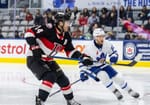Today the AHL formally announced they are cancelling the remainder of the 2019-2020 season and the playoffs. Previously, they had suspended operations along with the NHL in mid-March.
The AHL Board of Governors has voted to cancel the remainder of the 2019-20 AHL regular season and the 2020 Calder Cup Playoffs due to the ongoing COVID-19 public health crisis.
— AHL Communications (@AHLPR) May 11, 2020
Details: https://t.co/ySrY4Ryv6e pic.twitter.com/3aHSRBdvBf
Note: Information on Marlies tickets refunds is included in their statement today.
The formal cancellation affects players on AHL contracts and AHL team staff. All players on the Marlies (or the Newfoundland Growlers) on NHL contracts are still subject to the rules of the NHL and NHLPA about how they are to deal with the suspension of play and potential return to the current season.
In Toronto, the Maple Leafs parent company MLSE owns the Marlies, but approximately half of the AHL teams are not owned outright by their NHL affiliate. Those teams will struggle without playoff ticket sales and without season’s ticket sales which usually begin right about now as the playoffs raise interest.
HockeyDB.com tracks the official attendance figures for all AHL teams. In 2019-2020, the average home game attendance ranged from 9,043 per game for the Cleveland Monsters (Columbus affiliate) to 2,781 for the Stockton Heat (Calgary affiliate). The Marlies were in the middle with 5,648 on average, a low figure for them. Not all arenas are the same size, but the Coca-Cola Coliseum has a capacity of approximately 8,000 for a hockey game.
Beginning with the lockout year in 2012-2013, the Marlies began to grow their audience, and rode a wave of hot prospects like William Nylander, Andreas Johnsson and now Rasmus Sandin to fill the seats. This season, with a poor showing in the standings, and Sandin on the team only some of the time, there wasn’t a lot drawing the fans to games.
For independent teams like the Utica Comets, who come close to selling out their ~4,000-seat arena, the loss of revenue if they have to play next season without fans will be a heavy burden to bear. Most AHL teams do not have local television coverage, or if they do, it’s on a small local access cable channel and doesn’t pay much. AHL teams function on ticket sales and sponsorships — the sort of advertising partnerships that have the sponsors’ names on the side of the building, on the scoreboard or mentioned by the rink announcer more than the players. Without anyone to see or hear that, even proud local businesses who want to support their teams will think twice about continuing.
There is no simple solution for the AHL if they cannot go back to business as usual by next September. Not every NHL team will want to float them along until the revenue starts flowing, and there’s staff to be paid, bills to be paid, and costs that will mount up even if the teams hold off on the start of the season for a few months.
For the Ottawa Senators, who stepped up and bought their own affiliate and put them in a renovated arena in Belleville, they’re watching their excellent season, and the playoff tickets they would have sold, evaporate right when they need it the most. As an object lesson in the risk involved in committing funds you don’t have to the AHL, it’s a pointed one.
Some of the AHL teams, affiliates of NHL teams with a short roster of prospects and no willingness to spend on NHL-contracted players to play in the minors, spend a lot of money on AHL salaries. Teams like the Leafs, who paid Kalle Kossila a league-leading minors salary of $475,000 on his two-way NHL contract*, have driven up the price of AHL deals and priced the better players out of the reach of some poorer teams. That phenomenon could get a lot worse as teams get more strapped for cash. While it’s great to imagine being the rich man with the playing field tilted in your favour, like Toronto is, it’s not much of a game if no one else can afford to come and play.
The AHL is about to change over to a new commissioner, and they have a new CBA with their players that takes effect next season. Their new streaming service is a vast improvement over the old offering, and they’ve made inroads into getting some games on television on both sides of the border. They’ve been doing a lot of things right, and the game has become faster, better and more exciting. But it’s not a television product that can compete meaningfully in a marketplace with NHL hockey. All of that growth could be in jeopardy because it is ticket sales that keeps the league going.
The bottom line is the NHL needs a minor league system of some kind. The AHL isn’t going to vanish. But it’s possible the days of the independents in the small rinks strung across America might be waning. The move to NHL ownership, control and geographic proximity could get rapidly accelerated as the next season brings all new challenges to hockey.
For now, this becomes a season that never ended, and for the teams at the top like the incredible Milwaukee Admirals and their .714 win %, it’s a bitter pill in more ways than one.
*To clarify this point, there may be players on AHL deals making more than that, but we have no access to those numbers. There are definitely players on one-way NHL deals making considerably more, but few of them were expected to play in the AHL when they signed their deals. Kossila has the highest minors salary on a two-way deal.
Updated to add this fairly alarming quote from the outgoing commisioner:
David Andrews tells 'Hockey Central at Noon' that he expects @TheAHL to return at some point in 2020-21, but adds: "It might be something dramatically different than what it looks like now."
— Chris Johnston (@reporterchris) May 11, 2020




Comment Navigation & Markdown
Navigation
cc to focus on comments section
c next comment
x previous comment
z next unread comment
Inline Styles
Bold: **Text**
Italics: *Text*
Both: ***Text***
Strikethrough: ~~Text~~
Code: `Text` used as sarcasm font at PPP
Spoiler: !!Text!!